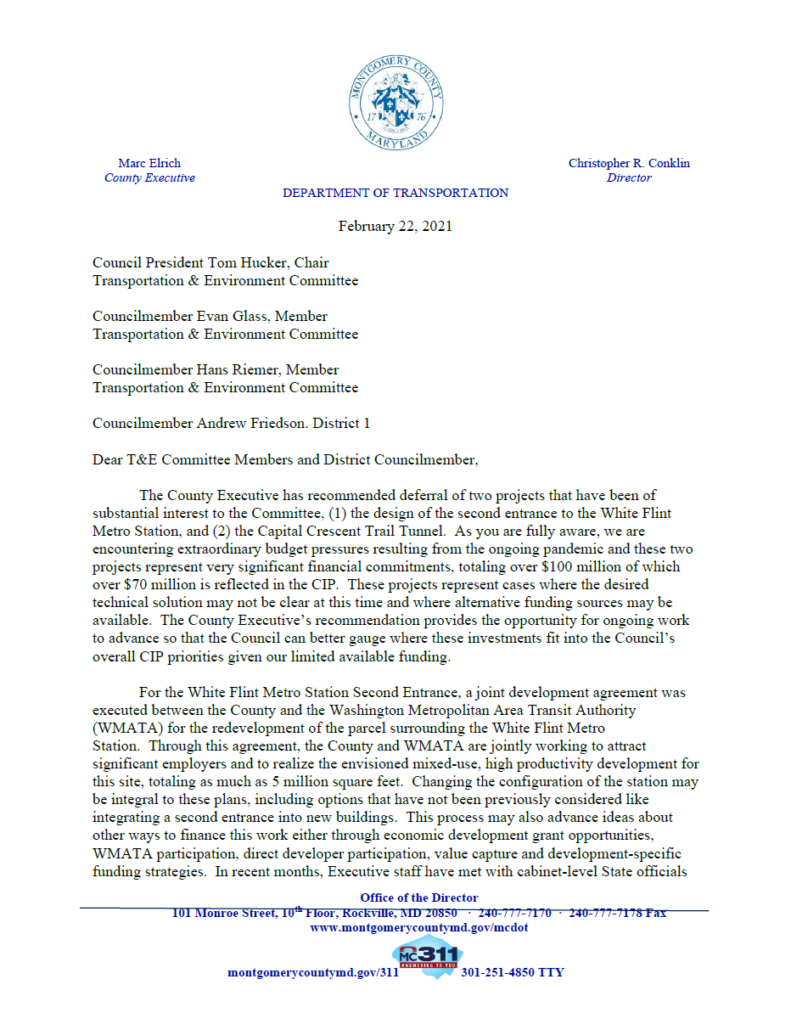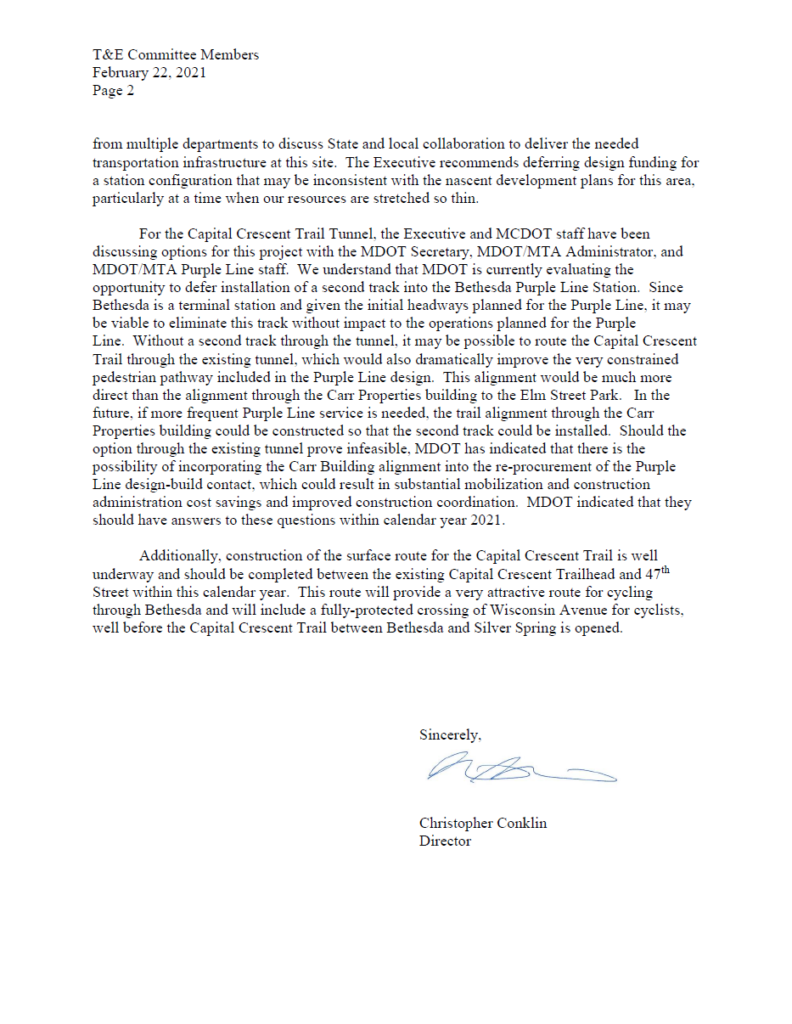By Adam Pagnucco.
In order to save money in the county’s capital budget, the administration of County Executive Marc Elrich has asked the state to single-track the Purple Line through a tunnel in Downtown Bethesda. That has aroused concern from Council Member Andrew Friedson, whose district includes the area, and advocates for both the Purple Line and its accompanying Capital Crescent Trail.
The Purple Line, the state’s light rail project between Bethesda and New Carrollton, has long been tied to the bicycle-pedestrian path known as the Capital Crescent Trail. The state is responsible for the Purple Line, the county is responsible for the trail and the two are supposed to run in parallel for most of the way between Silver Spring and Bethesda. The old version of the trail proceeded through an existing tunnel under Downtown Bethesda to enable pedestrians and bikers to avoid crossing Wisconsin Avenue, one of the most congested roads in the county. The new trail project is supposed to contain a new tunnel while the Purple Line uses the existing tunnel to connect to the Bethesda Metro Station.
Beset by tight bonding capacity and declining impact tax revenues, the county’s capital budget has been shrinking for years, forcing tough choices. In the prior version of the Capital Crescent Trail project, construction of the trail’s tunnel was supposed to “start in summer of 2024 with completion in late fall/early winter of 2026.” The executive’s new recommended version of the trail project delays the start of tunnel construction until FY27 or later. This follows a fight a year ago in which the executive did not include funding for the tunnel at all and the county council voted to add it.
This year is different in one respect. According to the executive’s new recommended trail project: “To provide an alternative approach, the County has requested that the State consider single-tracking through the Purple Line tunnel, freeing up space for the trail at considerable cost savings.” So instead of building a new tunnel, there would only be one tunnel containing one (not two) rail tracks plus the trail.
County transportation director Chris Conklin elaborated on the executive’s position in a letter to Friedson and the county council’s Transportation and Environment Committee. Conklin wrote:
For the Capital Crescent Trail Tunnel, the Executive and MCDOT staff have been discussing options for this project with the MDOT Secretary, MDOT/MTA Administrator, and MDOT/MTA Purple Line staff. We understand that MDOT is currently evaluating the opportunity to defer installation of a second track into the Bethesda Purple Line Station. Since Bethesda is a terminal station and given the initial headways planned for the Purple Line, it may be viable to eliminate this track without impact to the operations planned for the Purple Line. Without a second track through the tunnel, it may be possible to route the Capital Crescent Trail through the existing tunnel, which would also dramatically improve the very constrained pedestrian pathway included in the Purple Line design. This alignment would be much more direct than the alignment through the Carr Properties building to the Elm Street Park. In the future, if more frequent Purple Line service is needed, the trail alignment through the Carr Properties building could be constructed so that the second track could be installed.


Friedson pushed back hard against this idea, writing to his colleagues:
The County Executive’s suggestion to explore single-tracking the Purple Line in the existing tunnel in order to accommodate the new Capital Crescent Trail is highly problematic and would represent a dramatic departure from the County’s longstanding commitments to the community. To my knowledge, the Maryland Transit Administration (MTA) has never expressed that such an arrangement is feasible. Project plans were approved long ago and construction has already started. For those reasons, and based on deep concerns that single-tracking would delay travel times and light-rail vehicle headways, I am firmly opposed to the County Executive’s proposal. Even if an abrupt change to single-tracking is possible at this late stage, it would make this critical light-rail system less functional and would fall well short of our shared commitment to reliable, high-quality public transit.
Council staff, planning staff and the Washington Area Bicyclist Association also oppose the executive’s proposal.
This is not the first time that Elrich has proposed single tracking the Purple Line. Back in 2009, Elrich (along with Council Member Roger Berliner, who was Friedson’s predecessor) suggested single tracking the Purple Line inside the rail right of way in Chevy Chase that was then used as the original version of the Capital Crescent Trail. Elrich was interested in single tracking to save trees along the trail. The Maryland Transit Administration (MTA) responded with a statement noting longer travel times, less frequent service and lower passenger capacity on single-tracked light rail lines built in San Diego, Portland, Sacramento, and Baltimore. MTA concluded:
In sum, introducing a single-track segment between Bethesda and Connecticut Avenue would significantly compromise travel time savings, service frequency, passenger carrying capacity, and the maintenance and operating reliability of the Purple Line, thereby reducing the effectiveness, efficiency, and the return on a $1.3 billion investment. The reduction in the amount of tree clearance hoped for from building a trail and single-track segment would not likely be achieved. For the many reasons stated above the MTA strongly recommends against single-tracking any portion of the Purple Line.
In fairness to Elrich, the capital budget is extremely tight and the council’s move to reduce impact taxes used to pay for capital projects was not helpful. However, Elrich’s proposal to single track the Purple Line through a tunnel is a huge change to the project that could limit its effectiveness. The state should heed input from the county council, the county’s state legislators, the public and its own transit agency (which came out against single tracking a decade ago) before deciding on its merits.
